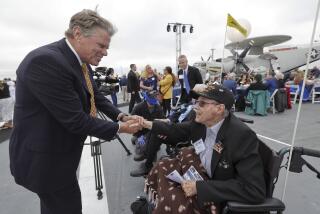The Nation - News from Aug. 4, 2002
- Share via
MIDWAY ATOLL — To World War II veterans, these remote islands one-third of the way from Honolulu to Tokyo will always be known as the site where the fortunes of war in the Pacific shifted in favor of the United States.
But ever since the Navy closed its air base here in 1993, more attention has been paid to the birds, turtles, seals and other wildlife that inhabited the atoll long before the military.
Since March, when an environmental tour operator shut down, public access to Midway has been very limited. Officials say they hope to restart such a service that could both protect the ecology and provide some visitation to the historic atoll of three tiny islands
Today, historians, veterans and government officials are left to balance Midway’s standing as both a national wildlife refuge and a military memorial.
“In a sense, that is a monument in and of itself to the veterans of Midway and World War II because only in a free, prosperous America could such a thing exist,” Assistant Interior Secretary H. Craig Manson said during a recent trip to Midway to commemorate the 60th anniversary of the Battle of Midway.
“I’d like to think that giving us the ability to do those two things here on this island, surrounded by these seas, is part of what you [veterans] were fighting for and is part of the legacy that you have left us.”
Not everyone agrees.
At least one Midway historian says not enough is being done to honor those who fought and died during the battle from June 4-6, 1942.
“American lives were lost, blood was shed and, clearly, this is a very important part of America’s culture and history,” said James D’Angelo, who founded the International Midway Memorial Foundation to raise awareness of the battle.
“Recognition is very important today because of the values that the men who fought in the Battle of Midway exemplified,” he added. Midway played a key role in World War II as a location that the Japanese sought to establish as a forward outpost. For three days, American dive bombers and fighter pilots fended off the Japanese naval fleet’s attempt to secure Midway, sinking four of the fleet’s carriers.
The atoll provided a key port for U.S. ships and submarines that allowed them to remain in the theater of battle without having to return to Pearl Harbor or the U.S. mainland for maintenance.
But Midway’s strategic importance has diminished over time.
The Naval Air Facility on Midway was closed and the atoll was turned over in 1996 to the Interior Department to be managed as a wildlife refuge.
Part of the wildlife refuge experience included ecotours -- a chance for the public to experience first-hand the pristine beaches, crystal-blue lagoons and even get up close with the ever-present gooney birds.
But contractor Midway Phoenix Corp. ceased operations in March, citing U.S. Fish and Wildlife Service restrictions that made it too difficult to be profitable.
Fish and Wildlife Service spokeswoman Barbara Maxfield has said that the agency tried to work with Midway Phoenix since it began operations in 1996, but that wildlife is the agency’s primary concern.
That doesn’t mean public access will be restricted for good. A temporary contractor has been brought in to maintain core services at Midway until a long-term operator can be found.
Critics such as D’Angelo say the agency has an opportunity to do more for the military while also maintaining standards for wildlife.
“The first step,” he said, “would be for the atoll itself to be recognized as a national memorial with a visibility point, when you arrive off the plane, to a large, visible sign that says it’s a wildlife refuge.”
Manson agreed: There is room on the atoll to accommodate history and ecology.
“We will honor, we will remember and, above all, we will thank you by what we do here both ecologically and historically,” he told veterans.
More to Read
Sign up for Essential California
The most important California stories and recommendations in your inbox every morning.
You may occasionally receive promotional content from the Los Angeles Times.













